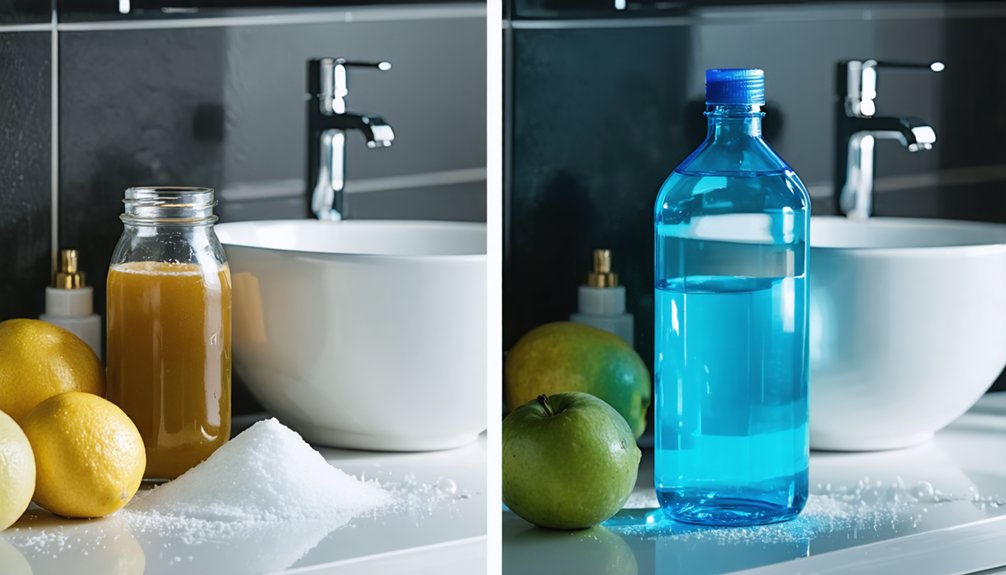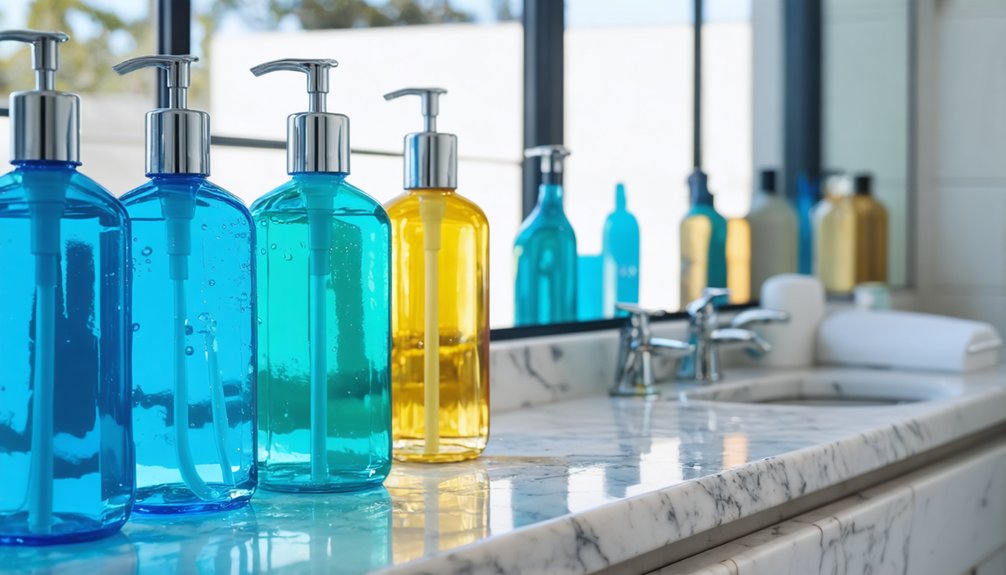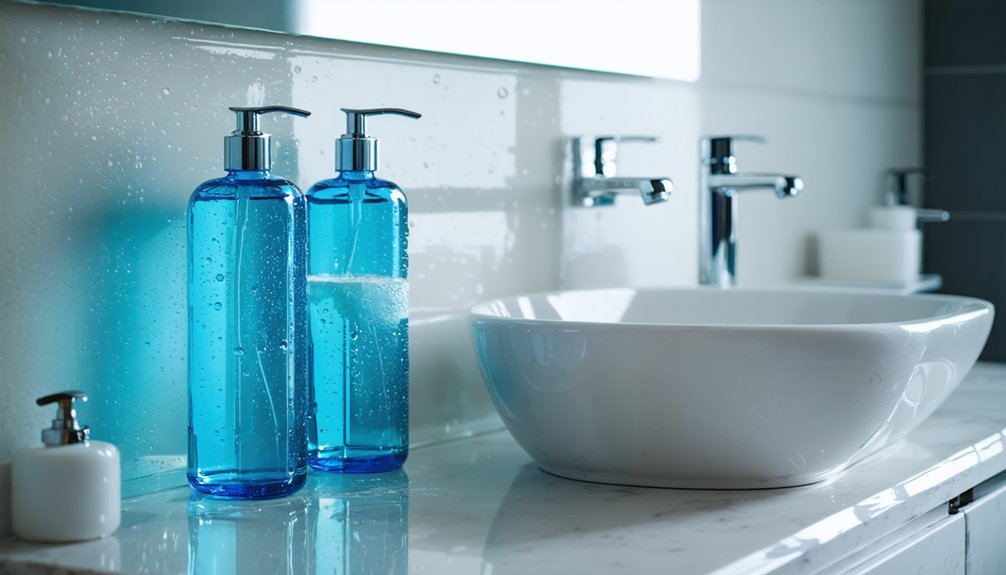You’ll find effective whitening results with mouthwashes containing hydrogen peroxide (1.5-2%) or sodium hexametaphosphate as active ingredients. Top-rated brands like Crest, Colgate, and Listerine offer proven formulations that can brighten teeth within two weeks of consistent use. For best results, rinse with 10-15mL twice daily for 60 seconds, and avoid eating or drinking immediately after. While over-the-counter options work well, understanding the science behind whitening agents can help you make the most informed choice.
Key Takeaways
- Crest whitening mouthwash contains peroxide-based stain removal agents that show visible results within two weeks of regular use.
- Colgate whitening mouthwash combines hydrogen peroxide with enamel protection features for safe and effective at-home brightening.
- Listerine offers alcohol-free whitening formulas with cetylpyridinium chloride that help remove surface stains while killing bacteria.
- For sensitive teeth, SNOW mouthwash uses controlled peroxide concentrations to whiten teeth while minimizing discomfort.
- Daily use of mouthwash containing 1.5-2% hydrogen peroxide for 60 seconds twice daily provides optimal whitening results.
Understanding Tooth Discoloration
While tooth discoloration affects people of all ages, its causes range from preventable lifestyle factors to unavoidable medical conditions.
You’ll encounter two main tooth stain types: extrinsic stains that appear on the enamel’s surface from foods, drinks, and tobacco, and internal discoloration that develops within the tooth structure itself. Addressing stains early through dental check-ups increases your chances of successful treatment.
Your daily habits, including coffee consumption, smoking, and oral hygiene practices, directly influence surface staining. Data shows that Southern states experience higher rates of tooth discoloration compared to other regions.
However, some discoloration stems from factors beyond your control, such as medications, dental trauma, or genetic conditions.
The color of stains often reveals their origin – yellow-brown typically indicates tobacco use or poor hygiene, while blue-gray suggests tetracycline exposure.
Understanding these distinctions helps determine whether home remedies might work or if you’ll need professional intervention.
Key Whitening Agents in Modern Mouthwashes
Modern whitening mouthwashes rely on several key active ingredients to combat tooth discoloration effectively. The primary whitening agents include hydrogen peroxide, which breaks down stain molecules through oxidation, and sodium fluoride, which strengthens your enamel while contributing to a brighter smile. ACT Whitening Mouthwash provides whiter teeth in just four days.
Innovative whitening mouthwashes harness the power of hydrogen peroxide and sodium fluoride to break down stains while strengthening tooth enamel.
You’ll find cetylpyridinium chloride in many formulations, offering antibacterial properties that help maintain oral health and prevent new stains. Today’s leading mouthwashes like Crest Pro-Health Advanced are specifically designed to be alcohol-free for sensitive users.
Other essential mouthwash ingredients include sodium hexametaphosphate, which acts as a protective barrier against future staining, and chlorhexidine, which provides powerful antibacterial action in prescription-strength formulas.
These components work together to not only whiten your teeth but also maintain ideal oral health through pH balance and bacterial control, ensuring both immediate and long-term results in fighting discoloration.
Top-Rated Whitening Mouthwash Brands
Leading the market in teeth whitening solutions, several reputable mouthwash brands have established themselves through proven formulations and consistent results.
Crest advantages include peroxide-based stain removal with noticeable results within two weeks.
Colgate effectiveness stems from its balanced approach to whitening and enamel protection, while Listerine flavors offer multiple options, including alcohol-free varieties for sensitive users. These products contain mild abrasives that help remove surface stains during rinsing.
You’ll find SNOW safety protocols particularly evident in their controlled peroxide concentrations, making it suitable for adult use while minimizing sensitivity.
ACT affordability makes it an accessible choice without compromising on quality, combining fluoride benefits with whitening properties.
Each brand delivers specific strengths, allowing you to select the most appropriate option based on your patients’ needs and preferences for at-home whitening care. Consistent twice-daily use over eight weeks is essential for achieving and maintaining noticeable whitening results.
Science Behind Mouthwash Whitening
The science of whitening mouthwash operates through specific chemical and mechanical actions that target tooth discoloration.
Unlike common whitening myths, hydrogen peroxide (1.5-2%) works by breaking down stain molecules through free radical release, while pyrophosphate compounds prevent new stains from adhering to your teeth.
You’ll find blue covarine creates an optical illusion of whiteness without actual bleaching.
Despite mouthwash misconceptions, these products primarily affect surface stains during their brief 60-second contact time.
They’re most effective when used to maintain results after professional bleaching treatments.
While abrasive agents like hydrated silica can remove external stains, they won’t change your tooth’s intrinsic color.
For best results, look for formulations containing both hydrogen peroxide and pyrophosphates, as this combination shows superior whitening maintenance in clinical studies.
Low pH levels in some whitening rinses can pose erosive risks to teeth.
For noticeable changes in tooth color, plan to use whitening mouthwash twice daily for 8-12 weeks.
Safety Considerations and Precautions
While whitening mouthwashes offer cosmetic benefits, proper safety protocols are essential to prevent adverse effects during use. You’ll need to follow usage guidelines carefully, including recommended frequency and duration, to protect your teeth and gums. Reading product labels thoroughly before use ensures proper application and optimal whitening results. Most whitening products should be used for every six months for optimal safety and results.
Monitor for sensitivity awareness, and if you experience intense discomfort, discontinue use immediately and consult your dentist.
Before starting any whitening regimen, verify you’re free from untreated dental issues like cavities or gum disease. If you’re pregnant, nursing, or have dental restorations, exercise extra caution or avoid whitening products altogether.
Always check with your dentist for untreated dental problems before whitening. Pregnancy, nursing, and dental work may require avoiding these treatments.
Remember to rinse thoroughly after use and consider incorporating desensitizing treatments. For best results, use whitening mouthwash as a maintenance product rather than your primary whitening method, and limit staining foods and beverages to maintain results.
Best Practices for Maximum Results
Achieving ideal results with whitening mouthwash depends on proper application techniques and consistent adherence to recommended protocols. For maximum effectiveness, you’ll want to incorporate the mouthwash into your daily oral hygiene routine after brushing and flossing. Rinse for 60 seconds, using the product 1-2 times daily for 8-12 weeks.
To enhance stain prevention, combine your whitening mouthwash with complementary products containing hydrogen peroxide or baking soda. Use a straw when consuming staining beverages, and avoid eating or drinking immediately after rinsing.
Remember to maintain consistent brushing and flossing habits, as clean teeth surfaces allow better contact with whitening agents. For best outcomes, choose alcohol-free formulations with fluoride and anti-plaque ingredients like sodium hexametaphosphate.
Natural vs. Chemical Whitening Options

While chemical whitening agents like hydrogen peroxide and carbamide peroxide deliver faster visible results through bleaching action, they can potentially cause tooth sensitivity with prolonged use.
You’ll find that natural alternatives such as coconut oil, citrus oils, and baking soda work more gradually by removing surface stains and preventing new discoloration.
Your choice between chemical and natural options should weigh the trade-off between quick results and gentle, sustainable whitening that supports long-term oral health.
Chemical Agents’ Quick Results
When comparing natural and chemical whitening agents, hydrogen peroxide emerges as the most effective option for rapid tooth whitening, producing a color change (ΔE) of 9.6 that surpasses other over-the-counter alternatives.
The chemical kinetics of peroxide-based agents allow them to penetrate tooth structure and react with organic compounds, delivering both surface stain removal and intrinsic whitening. For peak whitening efficiency, you’ll find that at-home treatments containing 10-16% carbamide peroxide provide significant results while minimizing sensitivity risks compared to higher concentrations.
Sodium bicarbonate presents a gentler alternative, achieving a ΔE of 7.6 through its abrasive and neutralizing properties. While it won’t match peroxide’s deep whitening power, it maintains better enamel integrity and causes fewer surface alterations.
Plant-Based Stain Fighters
Plant-based stain fighters offer a gentler approach to tooth whitening, utilizing natural compounds like coconut oil, peppermint oil, and activated charcoal to combat discoloration.
You’ll find coconut oil benefits include natural antibacterial properties that reduce plaque buildup, while peppermint oil properties provide both fresh breath and antimicrobial action.
When choosing natural whitening mouthwashes, you’ll need to balance effectiveness with safety. While lemon peel oil and citrus extracts can lift surface stains, limit their use to protect your enamel.
For best results, combine these natural solutions with consistent oral hygiene practices. Unlike chemical alternatives, plant-based formulas typically cause less sensitivity and enamel damage, making them ideal for those with sensitive teeth or ethical concerns about traditional whitening products.
Clinical Evidence and Research Findings
Research findings demonstrate that hydrogen peroxide-based whitening mouthwashes can help maintain tooth whiteness after professional bleaching treatments, though their effectiveness falls short of professional-grade products.
When evaluating whitening effectiveness, studies show that hydrogen peroxide concentrations of 1-2% in mouthwashes produce modest results over time.
Additional mouthwash ingredients like pyrophosphate and blue covarine can enhance whitening outcomes. Pyrophosphate works particularly well after enamel abrasion, while blue covarine creates immediate visual improvements through surface deposits.
You’ll find that 10% carbamide peroxide gels remain considerably more effective than any over-the-counter mouthwash.
However, if you’re looking to maintain results after professional treatment, whitening mouthwashes can serve as helpful maintenance tools when used consistently for several weeks.
Common Mistakes to Avoid

Despite the widespread availability of whitening mouthwashes, several critical mistakes can compromise their effectiveness and safety. One of the most common whitening mistakes is skipping an effective dental consultation before starting any whitening regimen. You’ll need professional guidance to guarantee your oral health can handle whitening treatments.
Don’t fall into the trap of overusing products or extending treatment times beyond recommendations. You’ll risk permanent enamel damage and increased sensitivity. Always follow manufacturer instructions precisely, and avoid mixing different whitening products.
Steer clear of unproven social media trends or DIY remedies that could harm your teeth. Additionally, maintain proper oral hygiene before and after treatments – brushing, flossing, and avoiding staining substances immediately after whitening are essential for ideal results.
Combining Mouthwash With Other Whitening Methods
You’ll achieve ideal whitening results by incorporating a whitening mouthwash into your daily oral care routine alongside professional treatments or at-home bleaching systems.
Your dentist can help create a personalized treatment plan that pairs compatible whitening products for maximum effectiveness while minimizing potential enamel damage.
When using professional bleaching treatments, you can maintain results longer by following up with a pyrophosphate-containing whitening mouthwash as part of your daily regimen.
Daily Whitening Treatment Plan
To maximize the whitening potential of mouthwash treatments, a thorough daily plan should integrate multiple whitening methods while maintaining ideal oral health.
Begin your daily regimen by brushing with fluoridated whitening toothpaste, followed by careful flossing to remove debris between teeth. Then swish with 10-15 mL of whitening mouthwash for exactly 60 seconds.
Routine consistency is essential—perform this sequence twice daily, morning and night. You’ll typically notice initial results within 1-2 weeks, though best whitening may take 8+ weeks of dedicated use.
Don’t exceed recommended usage times, as this won’t accelerate results and may cause sensitivity. For enhanced outcomes, limit staining beverages, avoid tobacco, and maintain regular dental checkups.
Choose alcohol-free formulas if you experience any irritation.
Pair Products for Results
Combining whitening mouthwash with other bleaching methods can greatly enhance and maintain your teeth whitening results. To maximize whitening synergy, pair hydrogen peroxide or pyrophosphate-based mouthwashes with professional treatments or at-home bleaching gels.
For peak product effectiveness, use Listerine Whitening or Colgate Plax Whitening after 10% carbamide peroxide gels or professional treatments with 25-40% hydrogen peroxide.
While mouthwashes alone won’t match professional whitening results, they’ll help extend and maintain your brightened smile. The most significant improvements occur within the first 7-28 days of combined use.
Be aware that some combinations may affect enamel microhardness, so follow product instructions carefully. Avoid pineapple extract-based mouthwashes, as research shows they’re ineffective at maintaining whitening results.
Professional Treatment Booster Steps
When pursuing professional teeth whitening treatments, a strategic combination of whitening mouthwash and other methods can greatly boost your results. To maximize mouthwash effectiveness, make certain your teeth are thoroughly clean and free of plaque before application. This allows ideal absorption of the whitening agents into your tooth enamel.
Choose alcohol-free formulations with fluoride to protect your teeth while whitening. Products like Crest 3D White Brilliance and ACT Whitening + Anticavity Rinse complement professional whitening techniques particularly well.
After your professional treatment, maintain results by incorporating whitening mouthwash into your daily routine. Remember to rinse thoroughly, reaching areas that brushing might miss.
For sensitive teeth, opt for gentle formulas like Sensodyne Pronamel or natural alternatives containing essential oils to prevent irritation while supporting your whitening goals.
Frequently Asked Questions
Can Whitening Mouthwash Remove Deep Stains Caused by Medication or Dental Work?
No, whitening mouthwash won’t remove deep stains from medication or dental work. Its limited whitening effectiveness and low peroxide concentration can only target surface stains during brief contact periods.
How Long Should I Wait After Eating Before Using Whitening Mouthwash?
Studies show 90% of whitening efficacy depends on timing. You’ll need a 30-60 minute waiting period after eating before using whitening mouthwash to allow your saliva’s pH to normalize and protect your enamel.
Will Whitening Mouthwash Affect the Color of Dental Crowns or Veneers?
Your whitening mouthwash won’t change your crown or veneer color since these restorations don’t respond to whitening agents. For ideal crown maintenance, choose alcohol-free formulas to protect bonding materials and restoration integrity.
Can Teenagers Safely Use Whitening Mouthwash Products?
You’ll find whitening mouthwash is generally safe for teens 14+ with healthy teeth, but consult your dentist first. For ideal teenage dental health, choose products with low peroxide levels and follow safe whitening practices.
Does the Temperature of Water Used With Mouthwash Affect Whitening Results?
You’ll get ideal whitening effectiveness using room temperature water with your mouthwash. Extreme temperatures can increase sensitivity and potentially compromise results, while moderate temperatures help maintain consistent whitening outcomes.
References
- https://pmc.ncbi.nlm.nih.gov/articles/PMC12080066/
- https://www.colgate.com/en-us/oral-health/teeth-whitening/best-whitening-mouthwash
- https://lumineuxhealth.com/products/whitening-mouthwash-16oz
- https://grantortho.com/teeth-whitening-toothpaste-and-mouthwashes/
- https://crest.com/en-us/oral-care-products/mouthwash/pro-health-advanced-extra-whitening-mouthwash
- https://gurunanda.com/blogs/mouthwash/can-mouthwash-whiten-teeth
- https://www.trysnow.com/blogs/news/teeth-whitening-ingredients
- https://my.clevelandclinic.org/health/symptoms/10958-tooth-discoloration
- https://pmc.ncbi.nlm.nih.gov/articles/PMC5036264/
- https://imagixdental.com/where-in-the-us-are-people-most-likely-to-have-discolored-teeth



